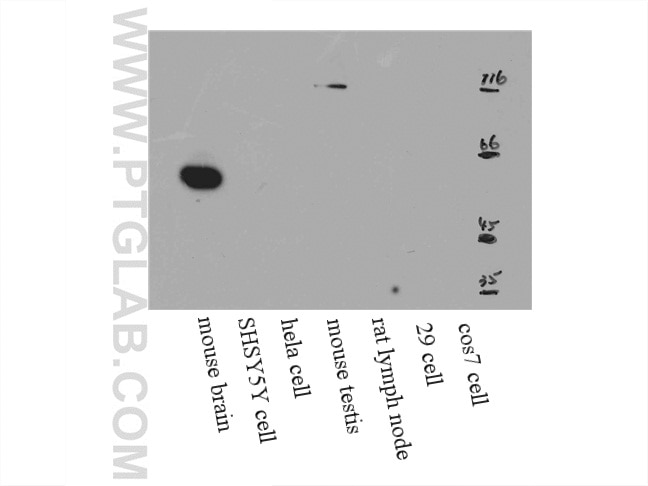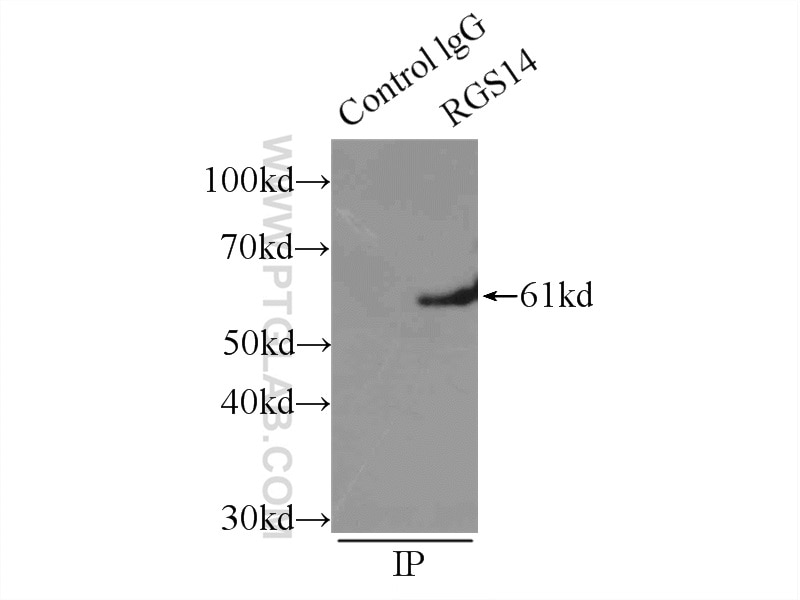Tested Applications
| Positive WB detected in | HeLa cells, mouse testis tissue, mouse brain tissue, mouse spleen tissue, HepG2 cells, HuH-7 cells, mouse liver tissue |
| Positive IP detected in | mouse brain tissue |
| Positive IHC detected in | mouse brain tissue Note: suggested antigen retrieval with TE buffer pH 9.0; (*) Alternatively, antigen retrieval may be performed with citrate buffer pH 6.0 |
Recommended dilution
| Application | Dilution |
|---|---|
| Western Blot (WB) | WB : 1:1000-1:4000 |
| Immunoprecipitation (IP) | IP : 0.5-4.0 ug for 1.0-3.0 mg of total protein lysate |
| Immunohistochemistry (IHC) | IHC : 1:2500-1:10000 |
| It is recommended that this reagent should be titrated in each testing system to obtain optimal results. | |
| Sample-dependent, Check data in validation data gallery. | |
Published Applications
| KD/KO | See 2 publications below |
| WB | See 6 publications below |
| IHC | See 3 publications below |
| IF | See 5 publications below |
| IP | See 1 publications below |
| CoIP | See 1 publications below |
Product Information
16258-1-AP targets RGS14 in WB, IHC, IF, IP, CoIP, ELISA applications and shows reactivity with human, mouse samples.
| Tested Reactivity | human, mouse |
| Cited Reactivity | human, mouse, rat, monkey |
| Host / Isotype | Rabbit / IgG |
| Class | Polyclonal |
| Type | Antibody |
| Immunogen |
CatNo: Ag9292 Product name: Recombinant human RGS14 protein Source: e coli.-derived, PGEX-4T Tag: GST Domain: 217-566 aa of BC014094 Sequence: KSLPLGVEELGQLPPVEGPGGRPLRKSFRRELGGTANAALRRESQGSLNSSASLDLGFLAFVSSKSESHRKSLGSTEGESESRPGKYCCVYLPDGTASLALARPGLTIRDMLAGICEKRGLSLPDIKVYLVGNEQALVLDQDCTVLADQEVRLENRITFELELTALERVVRISAKPTKRLQEALQPILEKHGLSPLEVVLHRPGEKQPLDLGKLVSSVAAQRLVLDTLPGVKISKARDKSPCRSQGCPPRTQDKATHPPPASPSSLVKVPSSATGKRQTCDIEGLVELLNRVQSSGAHDQRGLLRKEDLVLPEFLQLPAQGPSSEETPPQTKSAAQPIGGSLNSTTDSAL Predict reactive species |
| Full Name | regulator of G-protein signaling 14 |
| Calculated Molecular Weight | 566 aa, 61 kDa |
| Observed Molecular Weight | 60-65 kDa |
| GenBank Accession Number | BC014094 |
| Gene Symbol | RGS14 |
| Gene ID (NCBI) | 10636 |
| RRID | AB_2179918 |
| Conjugate | Unconjugated |
| Form | Liquid |
| Purification Method | Antigen affinity purification |
| UNIPROT ID | O43566 |
| Storage Buffer | PBS with 0.02% sodium azide and 50% glycerol, pH 7.3. |
| Storage Conditions | Store at -20°C. Stable for one year after shipment. Aliquoting is unnecessary for -20oC storage. 20ul sizes contain 0.1% BSA. |
Background Information
RGS14, a member of the R12 subfamily of RGS proteins, is highly expressed in the brain and is a natural suppressor of CA2 hippocampal synaptic plasticity and learning and memory. RGS14 was first identified as a complex scaffolding protein with an unconventional domain structure that allows it to interact with various protein binding partners. RGS14 contains one RGS domain, two Raf-like Ras-binding domains (RBDs), and one GoLoco domain. The protein attenuates the signaling activity of G-proteins by binding, through its GoLoco domain, to specific types of activated, GTP-bound G alpha subunits. Acting as a GTPase activating protein (GAP), the protein increases the rate of conversion of the GTP to GDP.
Protocols
| Product Specific Protocols | |
|---|---|
| IHC protocol for RGS14 antibody 16258-1-AP | Download protocol |
| IP protocol for RGS14 antibody 16258-1-AP | Download protocol |
| WB protocol for RGS14 antibody 16258-1-AP | Download protocol |
| Standard Protocols | |
|---|---|
| Click here to view our Standard Protocols |
Publications
| Species | Application | Title |
|---|---|---|
Mol Metab Hepatic Regulator of G protein Signaling 14 Ameliorates NAFLD through Activating cAMP-AMPK Signaling by Targeting Giα1/3
| ||
Brain Struct Funct Regulator of G protein signaling 14 (RGS14) is expressed pre- and postsynaptically in neurons of hippocampus, basal ganglia, and amygdala of monkey and human brain. | ||
Exp Neurol Modelling cognitive deficits in Parkinson's disease: Is CA2 a gateway for hippocampal synucleinopathy? | ||
J Biol Chem Human genetic variants disrupt RGS14 nuclear shuttling and regulation of LTP in hippocampal neurons. | ||
J Biol Chem RGS14 regulates hormone-sensitive NPT2A-mediated renal phosphate uptake via binding to the NHERF1 scaffolding protein. | ||
J Biol Chem 14-3-3γ binds RGS14 at distinct sites to inhibit the RGS14:Gαi-AlF4- signaling complex and RGS14 nuclear localization. |


















